Hold on a second. Hear me out. It’s not impossible. The Gaza Strip’s appalling situation can be fixed. Ok, it’s a Hail Mary, but the odds are better than we’ve seen for a while, and there is a lot of hard work happening. The secret ingredients? Time and patience, in just the right amounts.
Here’s the reality on the ground in Gaza: 44 percent unemployment—higher than any country on earth—and rising. Ninety-seven percent of Gaza’s water supply is unfit for human consumption, and getting worse. And following Palestinian elections in January 2006, the armed group Hamas—which Washington has named a terrorist organization—took over Gaza in June 2007. Hamas and Israel fought wars in 2008, 2012, and most recently 2014, killing about 70 Israelis and over 2,000 Palestinians, with plenty of skirmishes in between (including this past week). But Gaza is facing a humanitarian breakdown and so Hamas has an incentive to change.
Lately something’s been up. This past spring, Hamas unveiled a new charter and also stated: first, that it does not seek to intervene in other countries (which pleased Egypt); and second, that while “Hamas advocates the liberation of all of Palestine,” it is “ready to support a state on the 1967 borders.” While this does not meet Israel’s or the international community’s conditions for engaging Hamas (renouncing violence, abiding by previous agreements, and accepting the existence of Israel), it was enough to deepen Hamas’ discussions with the Palestinian Authority.
Then the Palestinian Authority, which spends about 40 percent—$1.6 billion—of its budget in Gaza, slashed salaries to their Gaza-based employees, most of whom haven’t worked for years and forced thousands of others into early retirement. The PA also cut back on paying for Gaza’s electricity payments, causing further blackouts. While these were certainly moves to pressure Hamas, this also begins the fiscal work the PA needs to do if it were to resume control over Gaza.
In early October, Hamas and the mainstream Fatah movement—which controls the Palestinian Authority—signed an agreement to allow PA security services to the borders of Gaza, something the international community has been pushing towards for a long time and has now been implemented. And the Trump administration apparently supported the deal to the extent that they asked the Israelis to go along with it. At the moment, the two sides are aiming for the PA to begin functioning in Gaza by mid-December, and then resolve the complex issue of merging the dual civil service workforces in Gaza, weeding out thousands of redundancies by February 2018. Through the process, the international community understands that the PA will need to weed out die-hard Hamas militants.
And weeks ago, Fatah and Hamas agreed to hold general elections in the West Bank and Gaza by the end of 2018. From Fatah’s perspective, the idea is that Palestinian society returns to being run on the foundation of a legitimate democratic process, one that ultimately leads to a constitutional democracy based on a negotiated two-state outcome. In other words: that Fatah defeats Hamas with ballots, not bullets. The outcome, assuming Fatah wins the election, is a unified Palestinian entity and government that recognizes Israel.
Palestinian Authority leader Mahmoud Abbas has the incentive of his legacy here: He’s aging, and despite hopes, odds for a final peace deal while he is still in power deal are slim. It currently seems that to secure one, he either sells out his principles, or Israeli Prime Minister Netanyahu (who recently stated: “The Jordan Valley will always remain part of Israel”) is suddenly willing to do his own about-face—something he has little incentive to do.
The core principles that Fatah and Hamas need to agree to and implement are as follows:
- One authority in both the West Bank and Gaza: The PA and Hamas need to agree that there will be only one government on the ground doing administrative services like providing education, health care, water, etc.—the Palestinian Authority;
- One political program: the PA and Hamas agree to follow a single political program of pursuing a two-state solution;
- And one gun: Hamas essentially gives up its weapons by placing them under the control of a unified government, currently dominated by Fatah.
As difficult as it may seem, here’s how that Gaza fix could work. The first two steps are already underway: Fatah and Hamas are already meeting to discuss how they can integrate the civil service and are continuing to discuss a joint political platform. This is tricky enough, and talks are tough and tenuous. It’s the third part, about the weapons, that is the most elusive—and where time and patience are essential. If Hamas truly gives up its weapons, it loses its greatest leverage. And it could also splinter if more radical elements refuse to do so.
Nonetheless, here’s a possible pathway: Following the proposed 2018 elections, Hamas would agree to give up its rockets. Hamas fighters agree to turn in their weapons to the Palestinian Authority. And the Palestinian Authority agrees to hire a proportion of those fighters into the Gaza branch of the Palestinian police force under the civil service reform program. An important note here is that the former Hamas fighters would only be able to be active within Gaza, and could not transfer to the West Bank. Why would Hamas agree to do this? And what would Hamas get in return? After a decade of abject pain, Gaza is in crisis. According to the United Nations, it’s almost uninhabitable. Its population has cried uncle, wanting another path rather than more wars. And that’s affecting Hamas’s standing in the tiny strip of land. Former—vetted—Hamas employees would get real paying jobs in the PA.
What else would Hamas get out of this? Israel and Egypt could agree to allow the residents of Gaza a far greater flow of people and goods in and out of Egypt. And Israel could even agree to allow a small, trial number of Gaza residents back to work inside Israel—currently there are next to none. Sound unthinkable? It’s not. For the past year there have been conversations underway about this between Israel, the United Nations, and the Palestinians on this. Indeed, in the mid-1990s, tens of thousands of Gazans traveled regularly to Israel to work, bringing much-needed income to the Strip. Of course there would need to be security checks. Former Hamas employees could get jobs in the PA, and trade could open up again with Egypt, Israel, and the West Bank. Tens of thousands of new jobs could be created as a result. Life would improve. Hamas would also get out of having to continue to govern Gaza, which has been an abject failure for everyone.
Would Egypt really push for this in the wake of the massive November terror attack in the Sinai that killed over 300 people? Yes—in fact, they just dispatched a security team to Gaza to advance negotiations which, if concluded and implemented, would restore PA control to all of Gaza. They may have an extra incentive: Returning PA security forces to the Gaza-Egypt border would only strengthen security checks. And fixing Gaza undermines at least a small part of the arguments by anti-government Sinai militants that the Egyptian government is doing nothing to help the Palestinians, and would also boost the anemic Sinai economy.
What does Israel get out this? They’d get the elimination of most—probably not all—Hamas rockets. They’d have a partner in the PA in shutting down Hamas’s military attack tunnels. And they’d probably get not only applause from the international community, but also from Saudi Arabia (which seems to be looking to stem Iranian influence in the Palestinian Territories), which could bankroll the effort, and which by working in an open and coordinated way on this deal would be doing a small amount of normalizing with Israel. Israel also would reduce the chances of another war with Gaza, which many fear might also include simultaneous fighting with Hezbollah in Lebanon in an effort to make themselves relevant to the Palestinian cause in the eyes of the Arab world.
Should the Trump administration push for this? The Trump White House already signaled to Israel and the Palestinians that they supported the redeployment of PA security forces to the Gaza border crossings earlier this fall. A reunified Palestinian body politic is a prerequisite to normalizing the West Bank and Gaza as one society and one political unit, and thus the implementation of a final peace deal.
No one will win a Nobel Prize for these kinds of steps, but they are steps in the right direction. Moreover, there are dozens of things that could go wrong. Just to name a few: The Gulf states could stop the flow of money. The PA might not have the stomach to root out militants in Gaza. Fatah could flub the elections. Hamas members could start to feel like they paid too high a price for too little if the economy doesn’t rebound. And of course an extreme faction of Hamas could refuse to go along, and attack Israel—though they would be marginalized and Israel would have a partner on the Gaza side of the border to hunt them down.
What’s Israel got to lose by trying? Very little, in my estimation; if they don’t like how they see this unfolding, they could, working with Egypt, close the gates once again. The greatest risks are to the Palestinian Authority and to Hamas. The PA would be putting their security services in harm’s way in Gaza. And Hamas, having just given up its rockets, wouldn’t have independent power if the deal falls apart. But what they have to gain would be far greater, at least in the eyes of the ordinary resident of Gaza: a growing economy and a more normal life.
With a conflict-ending peace deal unlikely, the reunification of the Palestinian political body in a manner that fits with the needs of Israel, Egypt, and the international community would be a tremendous boost to stability and prosperity today, and could be the single biggest contribution to the possibility of that hope-and-prayed for final deal in the future.
A Hail Mary? Indeed. But perhaps in this part of the world if one also seeks inspiration from Moses or Mohammad in addition to Mary for a bit of patience, success may be possible. And if even remotely possible, it’s worth a shot.



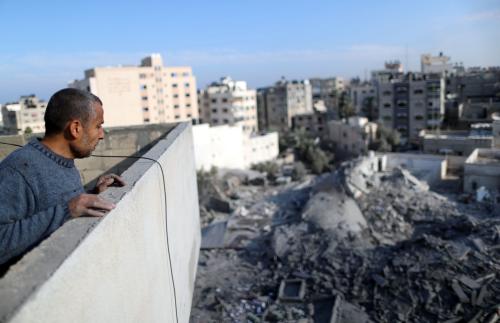
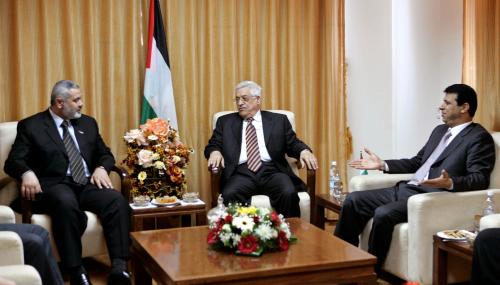


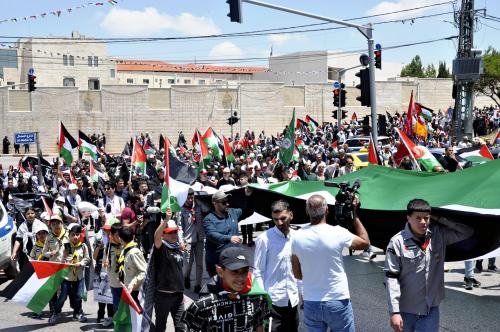
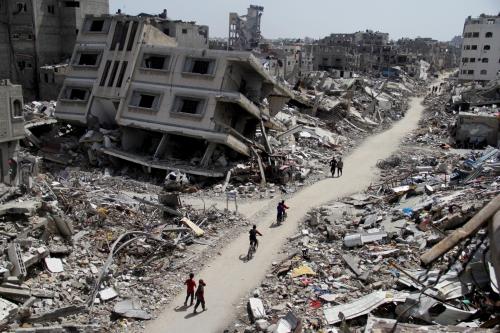
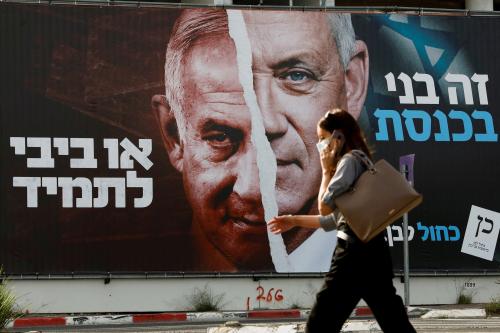
Commentary
Gaza—Is there a fix?
December 5, 2017